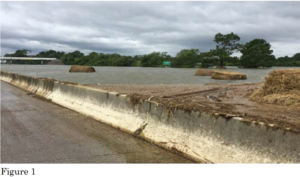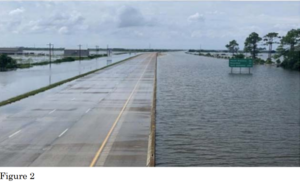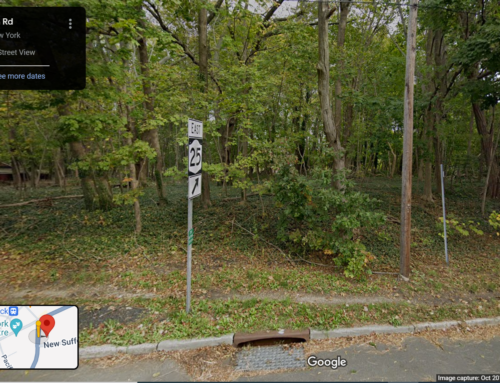 Devillier v. Texas is largely about a procedural nuance, but the pictures contain a message for people in right of way that matters even if the procedural nuance involved doesn’t change much day to day.
Devillier v. Texas is largely about a procedural nuance, but the pictures contain a message for people in right of way that matters even if the procedural nuance involved doesn’t change much day to day.
The eponymous Mr. DeVillier along with more than a hundred other parties to this U.S. Supreme Court Case own property in Texas north of U. S. Interstate Highway 10 between Houston and Beaumont. (The case has gotten to this level still at the initial pleadings stage, so the facts recited are essentially those most favorable to the plaintiff and aren’t to be taken as true.) The dispute here arose after the State of Texas installed a roughly 3- foot-tall barrier along the highway median to keep the south side of the highway open by blocking water. When subsequent hurricanes and storms brought heavy rainfall, the median barrier performed as intended. However, this resulted in water backing up onto petitioners’ land to the north, causing significant damage to their property. DeVillier filed suit in Texas state court. He alleged that by building the median barrier and using his property to store stormwater, Texas had effected a taking of his property for which the State must pay just compensation. This is essentially the “contingent retention pond theory” that we have been seeing in Virginia for some time. The complaint includes inverse condemnation claims under both the Texas Constitution and the Takings Clause of the Fifth Amendment. Texas moved to dismiss the federal inverse-condemnation claim, arguing that a plaintiff has no cause of action arising directly under the Takings Clause. The District Court denied Texas’ motion, concluding that a property owner may sue a State directly under the Takings Clause. The Fifth Circuit reversed, holding “that the Fifth Amendment Takings Clause as applied to the states through the Fourteenth Amendment does not provide a right of action for takings claims against a state.” 53 F. 4th 904.
The procedural nuance, in general terms, is whether the Takings Clause of the Fifth Amendment to the U.S. Constitution is what is called “self-executing” i.e. whether you can sue someone just by naming the Takings Clause as how you are suing them, or whether you have to sue them through some other procedural vehicle or cause of action. Usually that vehicle for vindicating federal constitutional rights would be what is called a Section 1983 claim, but Section 1983 has various procedural encrustations and curlicues and dead-ends that can make it difficult to use. It would be a lot easier for takings plaintiffs if they could just sue the state in federal court directly under the Takings Clause of the Fifth Amendment without having to go through other procedural vehicles (or the plaintiffs here seem to think so at least from how they postured their case given that they could easily have drawn it as a Section 1983 claim).
The unanimous Supreme Court, in an opinion authored by Justice Thomas, essentially dodges the question. The Court says that it does not need to decide the question because Texas state law provides an inverse-condemnation cause of action by which the plaintiffs can seek just compensation from the state based on both the Texas Constitution and the Takings Clause allows a remedy for violations of both the state and federal constitution.
Setting aside who is contending they “won” an opinion that doesn’t actually dispose of the case, there is a message in the pictures. Usually if the Supreme Court of the United States goes through the trouble of including pictures in the opinion, they are worth reviewing, and the two images in thise post are the ones included in the opinion.

Figure 1 above makes the structure here look like the world’s stoutest jersey barrier, although a standard jersey barrier impounding that much water seems hihgly unlikely. Figure 2 gives a cross-section view of the structure from above, making it look quite a bit different from the usual moveable pieces of concrete that go in between highway lanes.
Regardless, the message appears to be that inverse condemnation cases from flooding are on the rise (pun intended). With an inverse condemnation case based on flooding making headlines, right-of-way personnel can expect to see more of this kind of claim, more often. Plaintiff’s lawyers lawyers will likey try to allege an inverse condemnation case anywhere that flood water touches a structure belonging to an entity with condemnation power. This does not mean that the claims are valid, as every case is different and they often revolve around nuances of particular state law, which require experienced condemnation counsel to examine and defend.
Ross Greene is a firm shareholder and chair of the firm’s Eminent Domain / Right of Way Practice Group. He focuses his practice in the areas of eminent domain, real estate, wills, trusts, estates, and business matters.







Leave A Comment